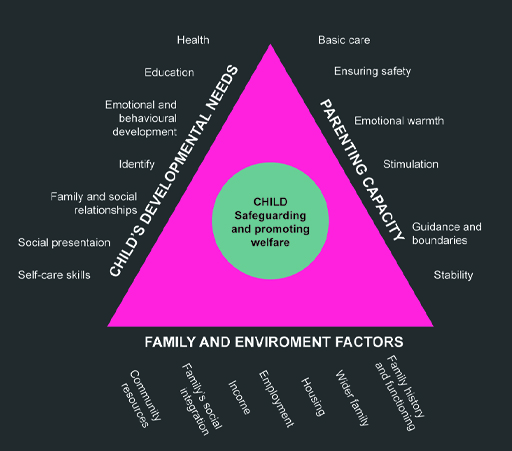2.1 Developmental needs of children
For social workers, a useful starting point for examining the breadth of knowledge considered important for child development is to examine the three ‘domains’ of the Department of Health (2000) assessment triangle. These demonstrate three areas for careful consideration when assessing children who may be in need, or at risk of harm:
- the child’s developmental needs, including whether they are suffering, or likely to suffer, significant harm
- parents’ or carers’ capacity to respond to those needs
- the impact and influence of wider family, community and environmental circumstances.
From the ‘child’s developmental needs’ left-side of the assessment triangle, an explanation of the seven items listed is as follows:
- Health: general health including dental; physical development; impact of disability; immunisations.
- Learning and education: understanding; reasoning and problem solving; attention span and concentration; progress and achievements; participation in learning, education and employment.
- Emotional development and behaviour: temperament; response to stress; appropriate self-control; coping strategies; lifestyle; antisocial behaviour.
- Identity and self-image: views and feelings about themselves; sense of belonging and acceptance by family; peers and wider society; experience of discrimination.
- Family and social relationships: quality of relationship with parents or carers and siblings; friendship patterns with peers and other significant people.
- Social presentation: understanding of how appearance, behaviour and any impairment are seen by others; appropriateness of dress for age, gender, culture and religion; personal hygiene.
- Self-care skills: acquisition of practical, emotional and communication skills necessary for increasing independence (taking account of the impact of any impairment).
There is no perfect measure for determining whether a child’s development may be delayed or impaired, either by innate genetic or biological influences or as a consequence of the quality or the amount of care the child has received. However, social workers observe and evaluate presenting behaviours and other reports about children’s difficulties, and then use their knowledge about what generally might reasonably be expected for children of a similar age, to assess whether there might be cause for concern about an individual child. Assessment almost always involves balancing a range of factors to reach an accurate and safe conclusion.
Next, you have the opportunity to attempt four quick questions, to be answered as either True or False, to help get you thinking a bit more about development.
Activity 2 Quick quiz on developments
a.
False
b.
True
The correct answer is a.
Answer
There are many situations where social workers engage with children and young people, e.g. looked after care, fostering and adoption, children in need, safeguarding, mental health, disability and so on. An understanding of child development theory will help social workers in any role or task that involves assessment or direct engagement with children and young people. It is important to remember that social workers will work in partnership with other professionals (and parents or caretakers) to share expertise and perspectives and produce a holistic understanding of children's wellbeing and development.
a.
True
b.
False
The correct answer is a.
Answer
In fact, child development encompasses a broader range of changes. According to Mussen et al., ‘development is defined as orderly and relatively enduring changes over time in physical and neurological structures, thought processes and behaviour’ (2004, p. 4).
a.
False
b.
True
The correct answer is a.
Answer
Development is a feature found across the life course although it may be interrupted and may not always progress in a linear fashion. Generally, the first 20 years of a person’s life is a remarkable period of developmental activity. It is a period when most developmental changes, according to Mussen et al., ‘result in new, improved ways of reacting - that is behaviour that is healthier, better organised, more complex, more stable, more competent or more efficient’ (2004, p. 4). Of course, there are exceptions, for example, where perhaps due to a disability a child experiences a delay to their growth or development. Beyond the period of childhood and youth development, change continues but without the same intensity and noticeable outcomes.
a.
True
b.
False
The correct answer is a.
Answer
The Children Act 1989 defines ‘development’ as physical, intellectual, emotional, social or behavioural development and ‘health’ as physical or mental health. In determining and defining which children are in need of services the Children Act 1989 has at its heart (in section 17) the child’s right to achieve and maintain a reasonable standard of health or development. This provision is mirrored in the Children (Scotland) Act 1995 (s.22). A child’s development must also be taken into account when a family court considers making a care or supervision order where the child’s development is ‘compared with that which could reasonably be expected of a similar child’. This comparison with a ‘similar child’ requires familiarity with the range of development any child might demonstrate. It also requires balancing the norms of development with the needs of the individual child (Daniel et al., 2010).

